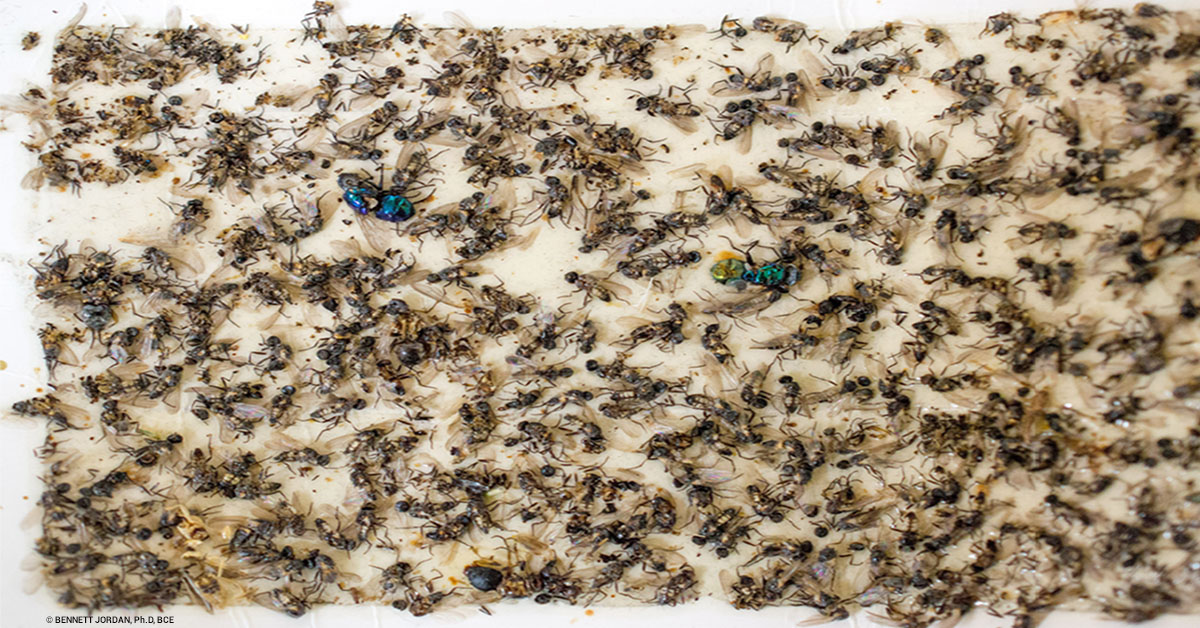By Bennett Jordan, PH.D., B.C.E.
Glueboards, sticky traps and insect monitors (or whatever you call them in your operation), provide an indispensable, and quantifiable, picture of what is going on at an account while you’re not there (when used appropriately, of course). Glueboards also can provide an early warning for emerging pest problems and help form the basis for pest trending over time. Despite their obvious advantages, they are not given the respect they rightfully deserve and are considered “boring” by many. As pest management professionals, we should be excited by the possibilities presented by a used glueboard. They are full of clues just waiting to be recognized and interpreted. An intrepid and observant problem-solver can use a glueboard to identify and correct a pest problem before it takes hold or halt a long-standing mystery. Misinterpreting, or outright missing, evidence can put your company in a precarious position with your clients.
EVERY PICTURE TELLS A STORY. Every glueboard that’s been placed in an account contains some evidence: it might be obvious, it might be subtle or it might appear that there is no evidence at all. Even a “blank” glueboard gives you something to work with. An untouched glueboard is telling you that either there is no pest presence in the area, or there are pests nearby but they are not interacting with the glueboard. It’s up to you to piece together the rest of the information you have from the environment around you to determine what’s more likely to be true. If there are sanitation and exclusion issues, maybe your placement isn’t optimal.
Obvious evidence certainly tells you something but deserves in-depth consideration. Take a glueboard with a single German cockroach. How is the cockroach positioned on the board? What might this suggest about its path of travel before it became trapped? Is it a nymph? Is it a female with an ootheca? Does this capture make sense in relation to conducive conditions nearby? Are you 100 percent sure it’s a German cockroach? Do you live in an area where Asian cockroaches are prevalent?
Identifying and interpreting the subtle evidence is where the fun begins. It also can separate the professionals from the professionals. I can’t begin to speculate how many glueboards we go through annually as an industry but the volume of information that’s unknowingly disposed of must be almost equally staggering. Anyone that’s analyzed glueboards under a microscope has found things they did not expect and that couldn’t be clearly made out with the naked eye. Pscocids and mites present on a glueboard are easily ignored or mistaken for debris because they are so minute.
DEVIL IS IN THE DETAILS. The level of detail you seek also can make a huge difference in your understanding of a situation. For example, hairs and feathers appear on glueboards occasionally, but they usually aren’t identified much beyond “rodent” or “bird.” Hair and feathers from different species have morphological features that reliably can be used to make positive identifications. There are even sufficient differences in types of hairs (guard vs. fur/underhairs) and feathers (contour vs. down) within an individual animal. It’s all about having the proper equipment, namely a high-powered microscope, and access to the right information. I highly recommend a book titled “Fundamentals of Microanalytical Entomology,” edited by Alan R. Olson, if you are serious about taking your investigative capabilities to the next level. Given the ramifications that the presence of rodents or birds present in a food facility, being able to make a species-level identification based on a stray hair or feather is invaluable. (You certainly want to rule out the possibility that what you’re seeing is a result of pet hair hitchhiking on an employee’s clothing. That brings up a whole different issue, clearly.)
There also will be situations in which you have a known pest but can easily miss a vital piece of information. We know that many stored product insects live in the immediate exterior of our accounts so when they begin showing up on glueboards indoors, how confident are we that we know their origin? It’s easy to say the problem is originating outdoors and lay blame on clients for their poor exclusion or personnel practices. (It’s also easy to assume that the problem must be originating indoors.) Conduct a close examination of the specimens and look for any clues that would indicate their origin; the biggest giveaway is pollen, most likely found on the setae or tarsi. This may be a long shot, but it only takes a few seconds to scan a specimen under the microscope and see if anything jumps out to you.
There are countless ways to use glueboards to your advantage — consider what has been highlighted here as just a drop in the bucket. Ask your pest control colleagues if they’ve run across anything unusual or cracked a challenging account based on glueboard evidence. Their answers and stories may surprise you. Monitoring is indisputably one of the pillars of Integrated Pest Management so let’s give it the attention and respect that it deserves.
The author is director of technical support and regulatory compliance, Copesan Services, Menomonee Falls, Wis.
This Tech Talk article was originally published in the April 2018 edition of PCT magazine.

